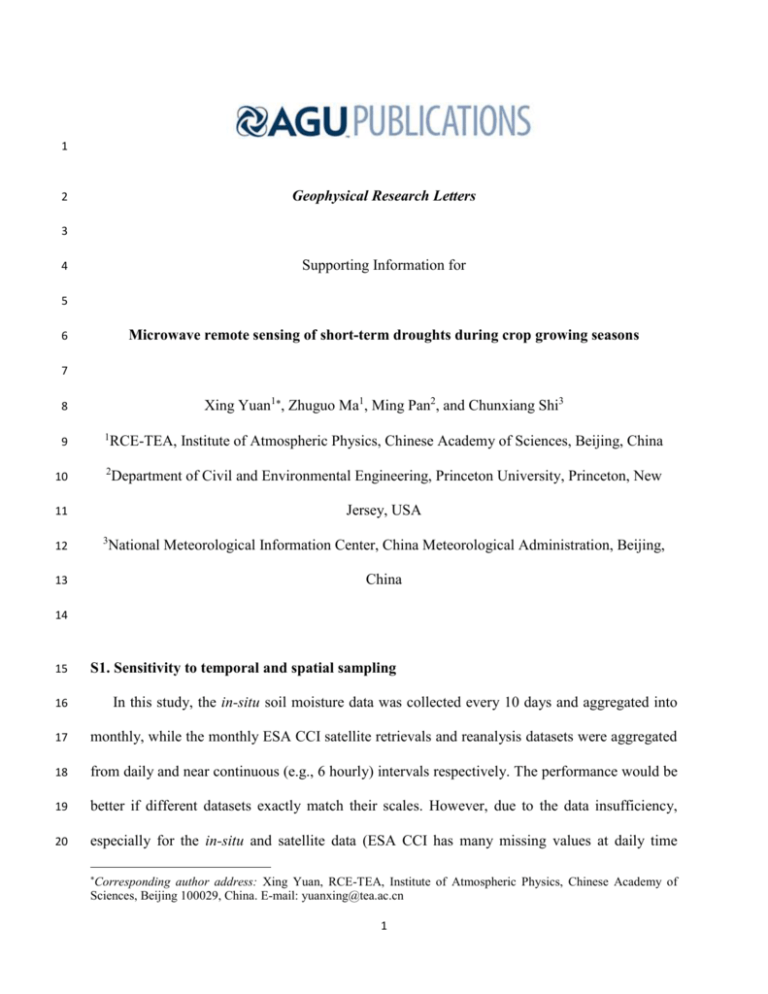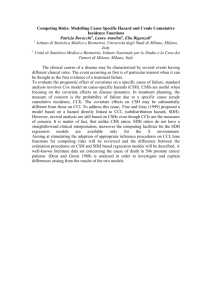grl52993-sup-0001-supplementary
advertisement

1 Geophysical Research Letters 2 3 Supporting Information for 4 5 Microwave remote sensing of short-term droughts during crop growing seasons 6 7 Xing Yuan1, Zhuguo Ma1, Ming Pan2, and Chunxiang Shi3 8 9 1 10 2 RCE-TEA, Institute of Atmospheric Physics, Chinese Academy of Sciences, Beijing, China Department of Civil and Environmental Engineering, Princeton University, Princeton, New Jersey, USA 11 3 12 National Meteorological Information Center, China Meteorological Administration, Beijing, China 13 14 15 S1. Sensitivity to temporal and spatial sampling 16 In this study, the in-situ soil moisture data was collected every 10 days and aggregated into 17 monthly, while the monthly ESA CCI satellite retrievals and reanalysis datasets were aggregated 18 from daily and near continuous (e.g., 6 hourly) intervals respectively. The performance would be 19 better if different datasets exactly match their scales. However, due to the data insufficiency, 20 especially for the in-situ and satellite data (ESA CCI has many missing values at daily time Corresponding author address: Xing Yuan, RCE-TEA, Institute of Atmospheric Physics, Chinese Academy of Sciences, Beijing 100029, China. E-mail: yuanxing@tea.ac.cn 1 21 scale), doing the analysis at monthly scale is a tradeoff between short-term drought analysis and 22 data adequacy. To evaluate the uncertainties in the monthly averages from just three in-situ 23 values, we performed a sampling sensitivity test using the ERA Interim reanalysis data and the 24 results showed no significant difference between drought indices calculated from three daily 25 values in the month, where the average hit rate, false alarm rate and equitable threat score 26 corresponding to Table 1 for ERA Interim are 0.36, 0.15, and 0.034, respectively. The sensitivity 27 to the spatial sampling (resolution) was shown in Table S1. 28 29 Table S1. The same as Table 1, but the datasets are firstly averaged into 1-degree grid cells, 30 where the drought indices and the statistics are then calculated and averaged over all 1-degree 31 grid cells with valid data. Data GLDASv1/CLM GLDASv1/Mosaic GLDASv1/Noah GLDASv1/VIC GLDASv2/Noah ERA Interim ESA CCI Merged ESA CCI Passive ESA CCI Active ESA CCI Merged (raw data) ESA CCI Passive (raw data) ESA CCI Active (raw data) H 0.34 0.34 0.35 0.33 0.42 0.38 0.36 0.35 0.39 0.36 0.40 0.51 F 0.15 0.16 0.15 0.15 0.16 0.15 0.16 0.14 0.15 0.18 0.26 0.32 ETS (10-2) 3.10 2.82 3.25 2.95 4.07 3.67 3.12 3.42 3.94 2.90 2.28 3.10 32 33 S2. Definitions of hit rate (H), false alarm rate (F) and equitable threat score (ETS) 34 Define a as the number of events when drought occurs in both the in-situ and reanalysis data, 35 b for when drought occurs in the reanalysis but not in the in-situ observation, c for when drought 36 occurs in the in-situ observation but not in the reanalysis, and d for when drought does not occur 37 in either the reanalysis or in-situ observation. Then, the hit rate (H) is 2 a , ac 38 39 40 41 42 43 (A1) where it is also called the probability of detection. The false alarm rate (F) is b , bd (A2) where it is the probability of false detection. The ETS (Equitable Threat Score) is a aref a aref b c where aref (a b)( a c) /( a b c d ) . 44 3 , (A3) 45 46 Figure S1. Dominant MODIS land cover type over mainland China. 47 4 48 49 Figure S2. ERA Interim monthly surface air temperature anomaly in July 2013. 50 5 51 52 Figure S3. Mean annual precipitation (mm) averaged during 1961-2013 for 17 river basins in 53 mainland China. 6






